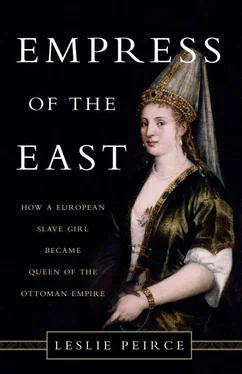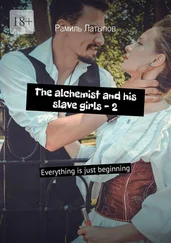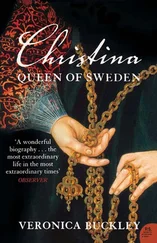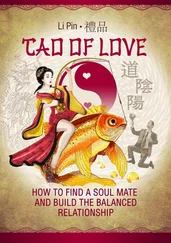TO BE SURE, the choice to surround the royal family with skilled converts was influenced by the teaching that a Muslim cannot enslave another Muslim. But the Ottoman sultanate did not hesitate to ignore the parallel teaching that a Muslim (monarchs included) cannot enslave a Christian or a Jew living under a Muslim government. While large numbers of imperial slaves came through legally approved sources—prisoners of war, purchased slaves of non-Ottoman origin—others came from the sultan’s own territories, particularly from frontier provinces. Such slaves were a kind of human tax levied on the empire’s Christian subjects.
The rationale most historians have offered for building the sultanic household with converted Christian slaves is that it bred loyalty. Severed from their homelands, the dynasty’s slaves were completely dependent on its largesse. In turn, they could expect reward for devoted service, especially the talented among them. Exceptional service garnered exceptional reward—riches, influence, and a fancy household of one’s own, all worlds apart from what was imaginable in one’s homeland. Flawed service like that of Ferhad, on the other hand, was rewarded with exile or execution. Under this system it was less risky for an Ottoman ruler to punish an uprooted slave than it was for kings and emperors elsewhere to discipline their noble servants without alienating powerful families.
The sultans had learned from their own struggles with aristocrats. The troubled early fifteenth century taught them about the unreliability of foreign vassal princes and, more dangerous, the dubious loyalties of native Turkish princes who had submitted to Ottoman rule. The nascent empire was nearly wiped out in 1402 when these presumed allies fled the battlefield at Ankara in the disastrous confrontation between Bayezid I and the Central Asian conqueror Timur (Tamerlane). It took over a decade of violence for one of the dead sultan’s sons, Mehmed I, to reunite the Ottoman territories.
For Mehmed II, the real architect of government by slave converts, this was all recent history. Born in 1432, “the Conqueror” grew up with knowledge of Bayezid I’s humiliating defeat and the subsequent rise of pretenders who rallied discontented Ottoman subjects to their banners, challenging his grandfather’s and then his father’s hold on the newly recovered throne. Mehmed diluted this troublesome structure by making convert Christians the backbone of his administration. As one element in this policy, foreign princesses were no longer taken as wives by Ottoman sultans and princes.
But the critical importance of loyalty to the dynasty still does not explain why the slave pool was so international. What the Ottomans were looking for—a broad knowledge base—could not be supplied by seeking slaves only from the empire’s own heartlands or from its immediate frontiers. As a state propelled by conquest, at least through the greater part of Suleyman’s reign, the empire kept adding new territories and, with them, new ways of life—languages, economies, modes of worship, cultural traditions. It also kept coming up against new rival powers across advancing frontiers. In such a kaleidoscopic world, it was politically expedient to assemble polyglot cadres who could literally speak with inhabitants of the provinces they might be sent to govern or negotiate with governments the Ottomans might want to trade or make peace with. In the case of the New Palace training school, the underlying principle seemed to be that a mélange of borderland recruits with a richly diverse talent pool would make for good military strategy and good foreign policy. In the case of the female harem of the Old Palace, the assumption seemed to be that a diverse gene pool through which the dynasty continually hybridized the world around it made for monarchs adept at managing an empire on three continents.
Did Roxelana feel torn between two worlds? If a royal concubine ever saw her family again, we do not hear of it. This is not to say that Roxelana and her fellow harem residents forgot their native lands or never spoke of them. The polyglot universe of the Ottoman ruling class probably encouraged new recruits to gravitate toward others who spoke their language. It was an obvious survival tactic to seek solidarity, protection, or guidance in making one’s way in this astonishing new world. On the other hand, memories of home might recede, especially for those who were children at the time of their capture. Occasions to reminisce, if any, were probably privately shared moments.
If longing for home and worry over the fate of her family clouded Roxelana’s efforts to adapt, if she feared that her diligence as a new Muslim betrayed her childhood faith, if memory of her abduction dogged her determination to keep that smiling countenance, she could draw some consolation from the fact that she was not alone in the struggle. Everyone was a convert, everyone learned a new tongue, everyone strove to please, and everyone had to forget. The rigor of the Old Palace educational program was surely a blessing in disguise. It organized new recruits into groups, and it kept them busy. The training system into which Roxelana was thrust was a meritocracy where the capacity to compete was what spelled success. Its encouragement of talent focused the more ambitious on advancement—on the future, not the past.
ROXELANA’S SUMMONS TO Suleyman’s chamber was a tribute to her success. The ultimate test, however, was whether he called her back and continued to do so until she became pregnant. As the Venetian Luigi Bassano, resident in Istanbul in the 1530s, explained the process to his readers, “The Grand Turk has a palace of women at quite a distance from his own. There he keeps a great number of young Christian slave girls. …From these the Grand Turk chooses whoever pleases him the most, and keeps her separate for two months, and amuses himself with her as he pleases. If she becomes pregnant, he takes her as his consort.” [20] Bassano, Costumi , chaps. 15, 17.
Roxelana had been groomed and guided to the point of selection by Old Palace women and eunuchs, whose job it was to produce solid choices for the sultan. Any of a number of individuals could have brought her to the sultan’s attention: Hafsa, a sister, a patron who had presented her to the court. Or perhaps Roxelana devised her own strategy to make herself noteworthy. But it was the sovereign who had the last say in a slave’s future.
Suleyman’s choice launched Roxelana on the career track that led to royal motherhood. No matter how she regarded her forced sexual submission to the monarch whose empire had enslaved her, she would understand that motherhood was the fastest route to a secure future in the competitive world of Ottoman royal politics. His summons exempted her from the career alternatives of continuing service in the Old Palace, perhaps culminating in the office of head stewardess, or, more likely, promotion from the palace as wife to a well-trained statesman with whom she would form another one of those satellite households.
Where did Suleyman “keep Roxelana separate”? He could conceivably have lodged her in an apartment retained for the sultan in the Old Palace (Menavino reported that Suleyman’s grandfather Bayezid II stayed there periodically for three or four days). But he almost certainly kept her in the New Palace, where he might more conveniently “amuse himself as he pleased.” The New Palace contained quarters for females known as the Hall of the Maidens, a small and confining offshoot of the inner courtyard, perhaps deliberately out of alignment with the strictly linear layout of the all-male palace structure. [21] Necipoğlu, Architecture , 159–162.
Its rooms functioned primarily to house the sultan’s current favorites and the staff who served them.
Читать дальше












